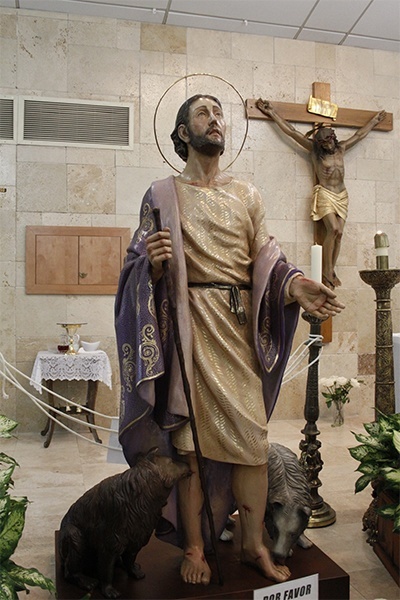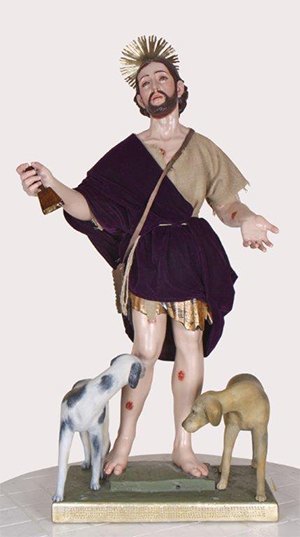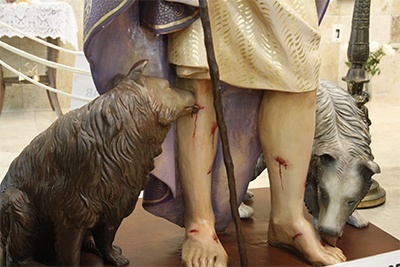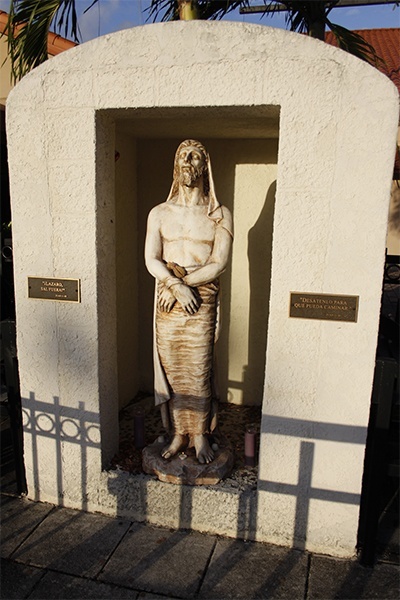By Ana Rodriguez Soto
- The Archdiocese of Miami

Photographer: ANA RODRIGUEZ-SOTO | FC
Image of Lazarus, the poor protagonist of the Gospel parable, acquired by San Lazaro Church in Hialeah. Despite the Cuban religious syncretism that also identifies him with a santeria god, devotion to the Lazarus of the parable - as opposed to the Lazarus whom Jesus raised from the dead - dates back to Spain in the Middle Ages.
HIALEAH | When San L�zaro�s parishioners celebrate their namesake feast Dec. 17, they will be venerating a new image that harks back to a very ancient devotion � a devotion that the Church in Cuba tried, unsuccessfully, to suppress for over a century.
�There were always two images � the people greeted the one of the bishop and went to pray to the other one,� said Father Jos� Espino, pastor of San L�zaro Parish in Hialeah.
He was referring to the two images of Lazarus housed in Havana�s San Lazaro del Rinc�n, a shrine attached to a hospital for lepers which was originally founded in the late 1600s.
One image depicted Lazarus as a bishop, the brother of Mary and Martha, Jesus� friend whom he raised from the dead. The other depicted Lazarus as the beggar from the Gospel parable: �There was a rich man who dressed in purple garments and fine linen and dined sumptuously each day. And lying at his door was a poor man named Lazarus, covered with sores, who would gladly have eaten his fill of the scraps that fell from the rich man�s table. Dogs even used to come and lick his sores.�

Photographer: COURTESY PHOTO
Image of Lazarus, the poor protagonist of the Gospel parable, as restored by the National Shrine of San Lazaro in El Rincon, Havana, Cuba.
Popular devotion to the beggar Lazarus far outstrips that enjoyed by his resurrected counterpart, especially among Cubans. The reason for that, in part, may be the religious syncretism that made the beggar Lazarus � along with St. Barbara and Our Lady of Charity � one of the most popular gods of santer�a practitioners.
To stem that syncretism, Havana�s bishop in the early 1900s decided to suppress the devotion to the beggar Lazarus and lead people toward the �true� saint, the risen Lazarus. One tradition holds that he ultimately became bishop of Crete. Another tradition confuses him with a third century bishop of Marseilles.
Regardless, Havana�s bishop took the image of the beggar Lazarus, removed the dogs and the sores, the beggar�s pouch and leper�s bell, and robed him in the red of a martyr, rather than the purple that harked back to the rich man�s clothes.
The people knew better, said Father Sergio Cabrera, rector of San L�zaro del Rinc�n � the popular name for what is officially the Santuario Nacional de San L�zaro en El Rinc�n (the National Shrine of St. Lazarus in the Havana suburb of El Rinc�n).
In an interview with the Florida Catholic during a visit to Miami earlier this year, he said when he asks people �which Lazarus do you pray to?� they reply, �The one with the crutches.� (Many images depict Lazarus on crutches as well, although that is not in the parable.)

Photographer: ANA RODRIGUEZ-SOTO | FC
Detail of the dogs licking the sores of Lazarus the beggar in the image now housed at San Lazaro Church in Hialeah.
Working on separate sides of the Florida Straits, Father Cabrera and Father Espino, who, coincidentally, were both appointed to their posts three years ago, realized that fighting such a popular devotion made no sense, especially in terms of evangelization.
More importantly, they looked into the history of the devotion and realized that it dates back to the Middle Ages. King Alfonso X of Spain opened up a hospital for lepers dedicated to Lazarus the beggar in the 12th century. There is a reference to Lazarus the beggar in the epic poem about El Cid Campeador. The oldest image of Lazarus the beggar resides in a church in Palencia, Spain. And in places throughout South America and the Philippines, hospitals and churches bear the name � and house images � of the beggar.
�The devotion dates to before the discovery of America. Throughout the Hispanic world, hospitals for lepers are dedicated to Lazarus,� said Father Espino.
Granted, there is no proof that he existed. But the Gospel itself is telling, Father Cabrera said. The parable of Lazarus is the only one in which a leading character is given a proper name. The Good Samaritan doesn�t have one. Neither does the Prodigal Son.
It is also the only parable that Jesus does not explain to his followers, an indication, Father Cabrera said, that people �knew whom he was talking about.� Also notable: �Our Lord depicts him as being in heaven, therefore making him a saint.�
Finally, there is the prayer of the Church at burials, which begs the angels to lead the deceased �to the bosom of Abraham; and where Lazarus is poor no longer, may you find eternal rest.�
After consulting with each other, Father Cabrera and Father Espino decided to ask their respective bishops for permission to �rescue the image of Lazarus the beggar,� in Father Espino�s words.
So the image of Lazarus in El Rinc�n, which had been vandalized in the 1990s, was restored. The restoration found evidence that he had, at one point, been depicted with dogs licking at his sores, with a beggar�s pouch and with a bell in one hand to indicate he was unclean and warn people to stay away. (Any skin blotches or imperfections were considered leprosy in the time of Jesus.)
Father Espino, for his part, commissioned a new, life-size image from Spain, which arrived in the parish at the beginning of November and now sits on the side of the sanctuary. It replaces a smaller image of Lazarus the beggar that he also had in the church, along with a life-size statue of the bishop.
Neither of the new images of Lazarus depicts him with crutches.

Photographer: ANA RODRIGUEZ-SOTO | FC
Image of Lazarus, the brother of Martha and Mary, friend of Jesus whom he raised from the dead. This outdoor shrine is at the entrance to San Lazaro Church in Hialeah.
�The iconography is not as important as the message,� said Father Espino, who plans to build a separate shrine to Lazarus the beggar on the parish grounds. It will complement the outdoor shrine to Lazarus the bishop which he built earlier.
�We venerate two images here, just as in El Rinc�n,� he said.
More importantly, he explained, the parable of Lazarus provides the scriptural and theological underpinnings for the Church�s social justice teachings.
�It�s a true pastoral approach that can be developed,� he said. �Because it�s part of the reason why the Church has dedicated itself to caring for the poor and lepers.�
�It�s an inescapable fact of faith: God speaks through his people. We wanted to impose upon our people the idea that Lazarus the beggar did not exist,� and yet the devotion only grew, Father Cabrera said.
In fact, El Rinc�n receives an average of 1,000 visitors a week, sometimes as many as 3,000, in a communist country where outward displays of faith are frowned upon. More than half a million people had visited between October 2012 and February 2013 and they represent the entire strata of Cuban society, Father Cabrera said. �By far, not all of them are santeros.�
�Pastorally, it�s not simply about changing the image. It�s about how to facilitate that a devotion that is so close to the people can lead them to Jesus,� he added. Perhaps the key to Lazarus� popularity is quite simple. �This is a poor man. He is close to the people. This poor man made it to heaven.�





